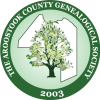Helping Others Can Have Unexpected Benefits
This is Part Two on the Search to Break a Brick Wall
Orlan Smith, of our local genealogy group, was given a possible hint as to who his Second-great grandfather’s parents might be by Karen from the museum on Grand Manan Island, New Brunswick.
Like I said in last month’s column, I went to the private library of Jay Bullard and looked at the town records of Woolwich, Maine. I traced the records of James Smith (III) and his wife Mary Curtis.
Jay also had the book “Founders of Town of Woolwich”. James Smith father Ebenezer Smith had a mini-biography. Ebenezer was born in the town of York in southern Maine. I found Ebenezer’s birth record in York’s vital records; he was the son of James Smith (Jr.) and Martha Bragdon.
Land records told me that this James was from Kittery/Portsmouth area. I found in earlier wills of Maine a will for this James’s (Jr.) father who was also named James (Sr.) and, yes he too was married to a woman named Martha Mills. So some children names were repeated from the first James (Sr.) and Martha by the Second James (Jr.) and Martha.
This is where the DNA test the member took helped to break his wall.
Orlan sent a copy of his DNA test to a Smith Family Surname web site to compare DNA test results with the others with the Smith surname. The Hosts of the website told Orlan, according to their review that first line of Smith that Orlan believed he was related to; that his line going to Samuel Smith from Portsmouth was not correct.
The hosts were able to tell Orlan that his line of Smiths did not match those of people from Jonathan Smith (the youngest son of Thomas & Mary Knapp Smith) out of Watertown, Massachusetts.
A road trip that Spike and I took last year to Bangor Public Library was a help because they had as part of their collection the Vital Records of Watertown, Massachusetts.
I copied the records of Watertown Smiths and typed the information into my genealogy program. Then I sent a copy to Orlan so he could look it over to see who and where he had to start a new search for his Aaron Smith parents or grandparents.
The original ancestor of the Watertown Smith was a man who was named Thomas Smith whose wife was Mary Knapp. This family was well documented. Thomas and Mary had 11 children. One son died young. The other ten children: eight sons and 2 daughters lived and founded families of very their own. Only the elder son moved out of Watertown to neighboring town Sudbury according to printed genealogy.
So this means the James (Sr.) who married to the Martha Mills was from this family. There was one problem! None of their eight sons were married off at the time of this James (Sr.) birth. I finally located an online copy of the original ancestor Thomas Smith’s will. This solved the brick wall.
Thomas in his will named his wife Mary. Then he named his Grandson James (Jr.) living in what was to become Kittery.
This was James (Jr.). He was the elder son of James Smith (Sr.) and Martha Mills. The James Smith (Sr.) had died nine years before his own father Thomas. Thomas then after naming his wife and the heir of his eldest son (James Sr.) then he named all the seven other sons followed then elder daughter and late younger dead daughter’s children.
The old man’s will reputes the printed genealogy. The person named for the eldest son, James of Sudbury. According to the printed genealogy, eldest son “James” did not die until eight years after Thomas Smith the original ancestry.
DNA trumped the late 1800’s genealogy. The Original ancestor will make it clear that eldest son James (Sr.) had moved to not Sudbury but to Maine and died in 1687. When James (Sr.) died in August 1687 his will listed his wife Martha Mills Smith and their four children James (Jr.), Mary, Elizabeth, and John. Martha Mills Smith remarried to a Christopher Grant about 1689.
The Indian raid of 1691 in November saw Christopher Grant wounded and would die of his injuries on the trek to Montreal, Quebec. Martha and her younger son John were taken to Montreal. Martha was placed with one family, her son in another. Her two daughters it appears taken during the raid but were never found afterward. Only the eldest son James (Jr.) escaped the Indians.
That is the reason Thomas listed this grandson separate. Because once the Indians and French raiders had made it back to Montreal the chances of recovery their captives were slim. They were as good as dead. So when Thomas wrote his will in 1696 and it was probated it had been nearly five years without any information on his widowed daughter-in-law or three younger grandchildren.
So Thomas wanted it clear that the double lot his estate that would have gone to his eldest son James (Sr.) went to the only known living grandson James (Jr.) in accordance with Mass. State Law.
After nearly 17 years Martha Mills Smith Grant and her son John Smith were allowed to return to British colonies. John would marry Elizabeth Heard and they had a large family.
James (Jr.) would swap land in Kittery for a farm in York, Maine. There he would meet and marry Martha Bragdon. Ebenezer Smith was their youngest son born in 1714. He married a woman whose first name is Hannah but her maiden name is unknown. They had James (III) who marry Mary Curtis and have 11 children. The first six were born in Woolwich. James and Mary were Loyalists and fled to New Brunswick, Canada.
Not sure where the younger five children including Aaron were born.
From a random query to the library in Grand Manan that is later passed on to Grand Manan Island Museum. Karen at the Museum happened upon that letter with a family group listing that had been received several years prior by the library. That letter was the key to solving Orlan’s brick wall.
Two random letters helped to end a long search to answer that old question: Aaron, “who’s your daddy?”



